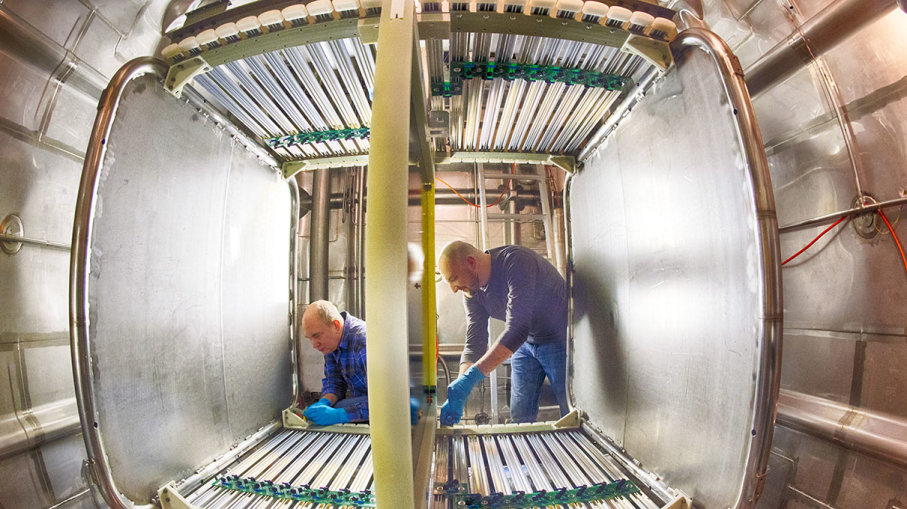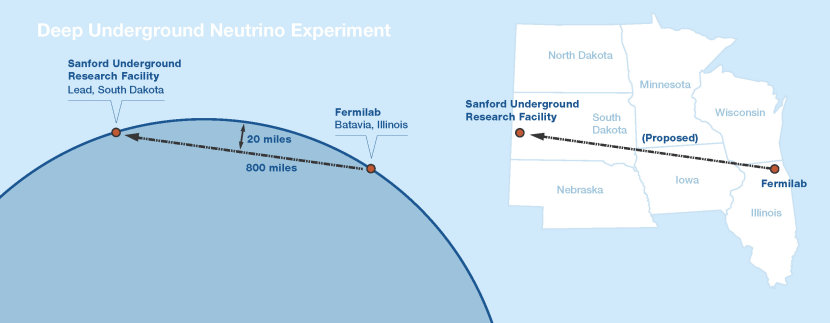Neutrino research in the near future

Workers install prototype DUNE detector
This summer, construction will begin in America for a new experiment in particle physics. DUNE - an experiment on neutrino detection deep underground, will explore several subatomic particles. In this experiment, scientists are going to shoot strong neutrino rays through the crust - the maximum depth will reach 48 kilometers. Perhaps this will allow to open several major mysteries of the universe.
The experiment conducted by the international collaboration of scientists, has a length of 1300 kilometers. Starting at the Fermi National Accelerator Laboratory, it will end at the Stanford underground facility.

')
Look deeper
Neutrino does not interfere with 1,300 kilometers of rock. A neutrino is a fermion with a zero charge and the smallest mass of all known particles. The speed of the neutrino approaches the speed of light, and they almost do not interact with ordinary matter. They spread freely throughout the universe without encountering obstacles.
How do scientists find them? For this we need cryogenic detectors. DUNE will include two underground detectors located 1,300 kilometers apart. An intense neutrino beam will be fired through these detectors consisting of large liquid argon tankers. How big? In height, the tanker will be like six floors, and at length as a football field. And it will be filled with seventeen thousand tons of chilled argon.
We know that neutrinos react very weakly with matter, as they are then noticed? Neutrinos, of course, weakly interact with matter, but a collision with the nucleus of an atom can occur. A small fraction of the particles from the directed beam will collide with an argon atom. Upon impact, there will be a flash, which detects the detectors inside. Then it will be possible to take for the analysis of the collected data. Due to the fact that the interaction is so weak, everything must be placed deep under the earth in order to isolate the detectors from cosmic rays and excess radiation.
Meet Neutrino
Scientists like to study neutrinos for many reasons, and one of them is the solar core. In a thermonuclear process, neutrinos and photons with high energy are formed. Photons are absorbed and re-emitted with less energy. This process takes place in a dense solar plasma and it takes up to a million years for the energy of the solar core to reach Earth. Thus, scientists are left to study the neutrino, which gets to our planet much faster.
But not everything is so simple with the solar neutrino. As we know, a neutrino can be of three "flavors" - electron neutrino, muon neutrino, tau neutrino, as well as their antiparticles. And when moving neutrinos can move from one state to another.
But when in the 1960s, scientists tried to detect these particles, they received far fewer collisions than predicted by theory. Soon, physicists found this cause. This happened just because of the neutrino transitions between the three “flavors”, when the detectors could detect only the electron neutrino. For this discovery was awarded the Nobel Prize.
Now we can go back to DUNE. This is a controlled experiment that will help you understand the changes in “fragrances”. It will be possible to compare the "flavor" of the emitted neutrino with that obtained. Thus, we have a wonderful opportunity to study the quantum nature of these transformations. Also, scientists can measure the mass of neutrinos with high accuracy, and who knows, maybe they will discover other "flavors".
More. Much more
Also DUNE will help to understand a rather important question - how our universe exists. The fact that the universe consists more of matter, and not antimatter, is one of the most important issues for modern science. In the big bang 13.8 billion years ago, matter and antimatter were supposed to arise in equal proportion. We know what will happen if they meet - they annihilate, leaving behind only the released energy. So if the proportions were equal, there would be nothing now.
What we are here means that during the big bang the basic laws of physics were violated. Scientists call this puzzle a symmetry violation of charge parity - or CP symmetry. Particle accelerators, like the hadron collider, can study this problem, and DUNE will also do this by experimenting with neutrinos and antineutrinos.
DUNE will be ready for operation in 2027. We hope that we will make great discoveries.
Source: https://habr.com/ru/post/374283/
All Articles